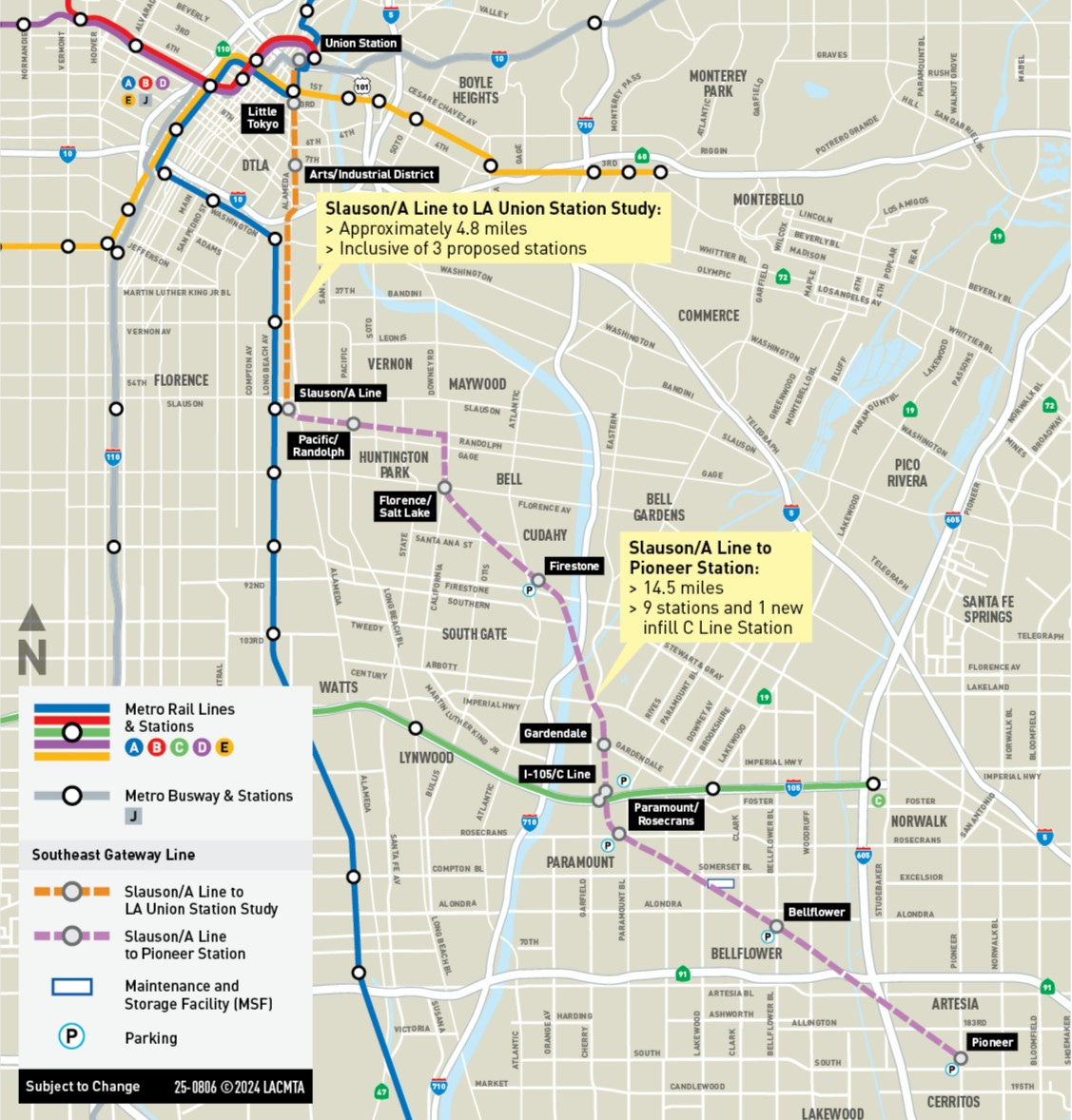Extending the Southeast Gateway Line to Union Station could cost over $9 billion
Metro is currently evaluating two options for the line: completely underground, and elevated along the median of Alameda.

The Southeast Gateway Line, planned to eventually stretch from the Gateway Cities to Downtown L.A., has just received its first significant update on the segment from Slauson to L.A. Union Station.
The project—formerly known as the West Santa Ana Corridor project—is a new light rail line being built from Artesia and the Gateway Cities, running through South L.A. alongside the A Line, and cutting through the Arts District until it reaches Union Station.
Project Background
The project is being built in two phases, with Phase 1 stretching 14.8 miles from the A Line Slauson Station to Pioneer Boulevard in Artesia. This part of the project is under active construction, with preliminary utility relocation underway and design approaching 30% complete.1 The first phase of the line is forecasted to open for revenue service in Fall 2035.2
The second phase, though, was studied as a separate part of the project. On January 19, 2022, the Board approved a separate study to “identify a cost-effective alignment route in lieu of the all-grade separated configuration currently assumed for the Slauson/A Line (Blue) to Union Station 4.5-mile segment.” 3 The purpose of the study was not only to cut costs associated with the segment, but also to get more public input from stakeholders in the segment, like Little Tokyo residents, Arts District tenants, and other community members.
The study was originally intended to be completed in parallel with the Environmental Impact Report (EIR) for Phase 1 of the Southeast Gateway Line, but it still hasn’t seen the light of day since then. Meanwhile, the Final EIR for the Slauson–Pioneer segment was approved in 2024, and that section is already under construction.

Alignments under study
Although there were originally six alignments under study before the project split,4 with options to connect to 7th St/Metro Center or to Union Station, the supplemental study studied only an alignment connecting to Union Station via Alameda (most similar to the above pictured E alignment).5
Since then, we haven’t really heard much about the study. The results of the study were scheduled for review by the Board in May, but that didn’t happen. Unrelated to the study, the Board did approve a stance prioritizing an underground alignment for the project when the environmental review process began.6 7
Now, though, we have more information. The SoCal Transiteer obtained a copy of the September 3rd Technical Advisory Committee Agenda via a public record request, which included the minutes for the July 2nd TAC meeting.
Note: Currently, agendas for non-board subcommittees are inaccessible through Metro’s main website because of their migration away from an internal calendar. All non-archived minutes and agendas must be requested through Public Record Requests.
During the July 2nd TAC meeting, we got the first real update for the Slauson–Union Station segment. According to the report, “Metro evaluated alignment concepts for the Union Station and Slauson/A Line segment.” The two concepts mentioned are quoted below:
1) The underground concept totaling $12.2 billion
2) The Alameda Aerial Median concept totaling $8.9 billion
This represents a significant increase over previous reported estimates; roughly $6.72 billion for an elevated alignment and $7.75 billion for a fully underground alignment.8
The Metro documents also noted that to combat the increased price tag, “Metro is exploring alternative funding sources such as an Enhanced Infrastructure Financing District (EIFD).”
Enhanced infrastructure financing districts have been pitched as a means to deliver several large-scale transportation projects across the region, most notably the second phase of the K Line's northern extension to Hollywood, where a chasm exists between the approximately $2.23 billion in local tax dollars identified for the project and estimated price tags ranging from $11 billion to $14.8 billion.
Next Steps
Although the increased price tag is not good news, the project appears to still be advancing. The northern segment of the Southeast Gateway Line is important, connecting the underserved Arts District gap and giving it well-deserved rail.
We’ll have to wait until the official release of the study to see what exactly the alignments will look like and their exact price tag. From there, the board will decide whether we continue to study this project and begin environmental review.
For more updates on the Southeast Gateway Line and other projects, consider subscribing to The SoCal Transiteer! You can customize what topics you want to read about, and it’s the best way to support us.
https://www.cpuc.ca.gov/-/media/cpuc-website/divisions/rail-safety-division/documents/monthly-reports/2025/rsd-quarterly-report--april--june-2025-fnl.pdf
https://metro.legistar1.com/metro/attachments/f4beca6e-92e1-4bef-8b46-e550d4203f13.pdf
https://datamade-metro-pdf-merger.s3.amazonaws.com/2021-0724.pdf
https://la.curbed.com/2018/2/14/17010590/new-train-stations-downtown-metro-west-santa-ana
https://www.metro.net/projects/southeastgateway/
https://metro.legistar1.com/metro/attachments/3ab74f4e-8ebd-4a7f-a7c4-24bfd100f3b3.pdf
https://la.urbanize.city/post/metro-moves-forward-plans-underground-southeast-gateway-line-dtla
https://la.urbanize.city/post/dtla-stakeholders-want-southeast-gateway-line-be-subway


